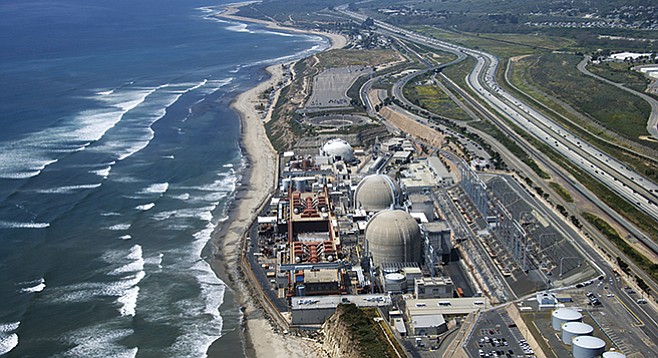 Facebook
Facebook
 X
X
 Instagram
Instagram
 TikTok
TikTok
 Youtube
Youtube

Piling on to issues already faced by the failed San Onofre Nuclear Generating Station and the state agencies that regulate it, including the California Public Utilities Commission and the California Coastal Commission, nuclear watchdog group Alliance for Nuclear Responsibility has filed new public commentary critical of planning figures cited in the CPUC's 2015 Draft Integrated Energy Policy Report.
A first offense, says the group, is an assumption that San Onofre's former operator, Southern California Edison, will "complete the full decommissioning process within 20 years. California further requires the decommissioned plant site be restored to its original condition; this requirement involves additional activities beyond what the NRC may require."
Alliance counsel John Geesman argues that a true "decommissioning" of the plant involves removal of all spent nuclear fuel from the site and a restoration of the grounds to their natural state, a stipulation present in a long-term land lease with the Navy.
The rosy picture painted in the report can't be accurate, Geesman continues, because Edison uses "optimism premised on the federal government beginning to take delivery" of San Onofre's nuclear waste sometime in 2024, with all waste removed from the site by 2049 and an actual site decommissioning date of 2052 — that's 37 years from now.
Sources have predicted in the past that nuclear waste could end up sitting along San Diego's northern shoreline for as long as 600 years or more if plans to build a federal nuclear waste dump don't come through.
The delays in moving the radioactive waste off site could lead to massive cost overruns as compared to the CPUC's assumptions — according to Geesman, Edison says a ten-year delay in moving the waste would increase storage costs by $149 million (in 2014 dollars), and that a 100-year delay would cost upward of $1.5 billion.
Another argument hinges on Edison's contract with the Navy to return the land to its original condition before construction of the power plant. While Geesman says that ratepayer contributions to a decommissioning trust are sufficient, Edison "nevertheless is attempting to remove the requirement from a renegotiated agreement with the Navy....
"About 42 percent of the $346 million cost of compliance is due to the requirement that all clean concrete and demolition debris be disposed of at an out-of-state Class III landfill pursuant to State of California executive Order D-62-02.18.68," continues Geesman. "The final [report] should condemn any notion of abandoning subsurface debris, ineligible even for deposit in a California landfill, on what may one day become a heavily visited public beach."
The Alliance for Nuclear Responsibility then turns its attention to Diablo Canyon, the state's last active nuclear power plant, which itself is facing difficulties in trying to renew its operating license amid many of the same concerns that would have plagued San Onofre had it not failed before filing renewal applications, including questions about earthquake fault lines running close to the plant.


Piling on to issues already faced by the failed San Onofre Nuclear Generating Station and the state agencies that regulate it, including the California Public Utilities Commission and the California Coastal Commission, nuclear watchdog group Alliance for Nuclear Responsibility has filed new public commentary critical of planning figures cited in the CPUC's 2015 Draft Integrated Energy Policy Report.
A first offense, says the group, is an assumption that San Onofre's former operator, Southern California Edison, will "complete the full decommissioning process within 20 years. California further requires the decommissioned plant site be restored to its original condition; this requirement involves additional activities beyond what the NRC may require."
Alliance counsel John Geesman argues that a true "decommissioning" of the plant involves removal of all spent nuclear fuel from the site and a restoration of the grounds to their natural state, a stipulation present in a long-term land lease with the Navy.
The rosy picture painted in the report can't be accurate, Geesman continues, because Edison uses "optimism premised on the federal government beginning to take delivery" of San Onofre's nuclear waste sometime in 2024, with all waste removed from the site by 2049 and an actual site decommissioning date of 2052 — that's 37 years from now.
Sources have predicted in the past that nuclear waste could end up sitting along San Diego's northern shoreline for as long as 600 years or more if plans to build a federal nuclear waste dump don't come through.
The delays in moving the radioactive waste off site could lead to massive cost overruns as compared to the CPUC's assumptions — according to Geesman, Edison says a ten-year delay in moving the waste would increase storage costs by $149 million (in 2014 dollars), and that a 100-year delay would cost upward of $1.5 billion.
Another argument hinges on Edison's contract with the Navy to return the land to its original condition before construction of the power plant. While Geesman says that ratepayer contributions to a decommissioning trust are sufficient, Edison "nevertheless is attempting to remove the requirement from a renegotiated agreement with the Navy....
"About 42 percent of the $346 million cost of compliance is due to the requirement that all clean concrete and demolition debris be disposed of at an out-of-state Class III landfill pursuant to State of California executive Order D-62-02.18.68," continues Geesman. "The final [report] should condemn any notion of abandoning subsurface debris, ineligible even for deposit in a California landfill, on what may one day become a heavily visited public beach."
The Alliance for Nuclear Responsibility then turns its attention to Diablo Canyon, the state's last active nuclear power plant, which itself is facing difficulties in trying to renew its operating license amid many of the same concerns that would have plagued San Onofre had it not failed before filing renewal applications, including questions about earthquake fault lines running close to the plant.
Comments